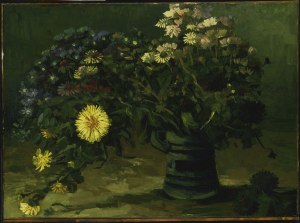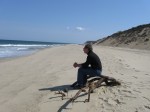“What the hell is wrong with you, Neil?” my unsubtle editor Edgar Reewright shouted into the phone a couple of weeks ago. He had called moments earlier with a special request — he wanted me to compose a story about sunflowers — and I had balked at the idea. “I mean, what do you have against sunflowers? Just about everybody likes sunflowers, right? Right. Furthermore, if they were good enough for Vincent van Gogh, who, unlike yourself, was a genius, then they damn well are good enough for you.”
“Neil,” Edgar continued, “have I ever asked anything of you before? Other than demanding high payments to compensate me for the extraordinary pains I take to make your writings intelligible, the answer is no. I haven’t been myself the last few weeks, so a bright, cheerful piece about the sunniest of flowers probably will boost my spirits. Write it!”
“Listen, Edgar,” I said. “I’ve got nothing against sunflowers. On the contrary, I love them. I mean, they’re just adorable. Big and grinning, and their gangly stalks are so improbable. They’re like dogs that want nothing more than to please you, that know they’re goofy and would have it no other way.”
“So, what’s the problem, Neil?”
“Well, it’s just that I’ve written quite a few nature-related articles the last several years. I don’t want to overdo it, you know.”
“Overdo it? Neil, you can’t go wrong with nature. And I highly doubt if you have anything better to write about right now, anyway.”
“Oh yeah? Listen, Edgar, I’m planning to do a piece on the wonders of napping. I’ll explore its ins and outs: how I position my head just so on the living room sofa before nodding off, for instance. And how I awake 10 or 15 minutes later with glazed eyes, uncertain where the hell I am. Edgar, I’m one hundred percent certain that the readers of that article will be enthralled. My exciting revelations will have them panting for more.”
A few seconds passed. And then Edgar had this to say: “A short while ago I asked, ‘what the hell is wrong with you, Neil?’ And I was right on the money, because a better question hasn’t been posed anywhere in the world today! Napping? You’ve got to be kidding me! Listen up, haven’t I always strived to help you create agreeable product?”
“Yes, that’s very true, Edgar. I don’t know how you do it, but you whip my reportage into decent shape.”
“Thank you, Neil. Even though I’ll never figure you out, I have to admit that anybody who unashamedly uses a clunky word like reportage in conversation can’t be all bad. Okay then, I strongly recommend that you drop the napping idea and move on to sunflowers. Are we on the same page?”
We were.
Thus, during three walks in the latter half of July, in my neighborhood and in nearby towns, I kept an eagle eye out for sunflowers, and found about 15 homes on whose grounds they were displayed. Having strolled past hundreds of houses, though, I was a bit surprised by the low percentage that carried this form of joyful flora. But little matter. Every sunflower that I saw smiled at me. They truly were glad to see me, and the feeling was mutual.
But you know what? Despite the time I spent with real-life sunflowers, I have to admit that I much prefer a particular Vincent van Gogh sunflower painting over them. Vincent painted sunflowers a dozen times, and one of those oils hangs within the Philadelphia Museum Of Art, where I have passed hundreds of hours. (I’ve lived in Philadelphia or its suburbs for most of my adult life.) It very well might be the most popular art work in the museum. It certainly is one of mine.

Vincent had the abilities to find the hearts and souls of his subjects, to bring his subjects alive in both traditional and unexpected ways. And he did exactly that when he painted the canvas in question in 1889. It is glorious and imbued with vigor. It has deep stories to tell. Sunflowers never have looked so good.
(My editor has been getting on my frigging nerves big-time. So, you know what? F*ck him! I won’t allow Edgar to edit this article. I’m going to press the Publish button right now. Please don’t be shy about adding your comments. Mucho gracias.)








